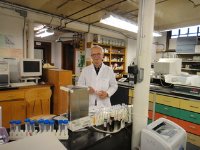Answer to the question: Which papers on environmental science, ecology, protection of environment, protection of water quality were downloaded most recently? https://www.researchgate.net/post/Which_papers_on_environmental_science_ecology_protection_of_environment_protection_of_were_downloaded_most_recently#share The following papers were downloaded most recently (in 2014, during recent 24 h) on the topics: environmental science, life science, ecology, water quality: http://5bio5.blogspot.com/2014/01/in-2014-new-year-activity-interest.html links, web pages to get the full texts: publications on environmental science, life science, ecology, water quality; at ResearchGate, see: https://www.researchgate.net/profile/S_Ostroumov/contributions/?ev=prf_act ** Researchers who...
В МГУ имени М.В.Ломоносова проведены исследования, которые внесли вклад в научные основы экологической безопасности источников водоснабжения — поверхностных водных экосистем (таких, как водохранилища, озера, реки), см.: 5bio5.blogspot.com/2012/08/revolutionary-innovation-ecosystem.html
Ключевые слова: качество воды, водоснабжение, водные ресурсы, экологическая безопасность, охрана окружающей среды, водохранилища, озера, реки, водные экосистемы, охрана...
Ключевые слова: качество воды, водоснабжение, водные ресурсы, экологическая безопасность, охрана окружающей среды, водохранилища, озера, реки, водные экосистемы, охрана...
Paper: On the Biotic Self-purification of Aquatic Ecosystems: Elements of the Theory
Comments, in Chinese — see online:
d.wanfangdata.com.cn/NSTLQK_NSTL_QKJJ022370379.aspx;
key words: water, water quality, pollution, pollution prevention, control, ecotoxicology, improvement, freshwater, sustainability, lakes, rivers, streams,
Comments, in Chinese — see online:
d.wanfangdata.com.cn/NSTLQK_NSTL_QKJJ022370379.aspx;
key words: water, water quality, pollution, pollution prevention, control, ecotoxicology, improvement, freshwater, sustainability, lakes, rivers, streams,
Сайты о вопросах безопасности питьевой воды :
Drinking Water Contaminants:
www.epa.gov/safewater/contaminants/index.html
Guidelines for Drinking Water Quality (World Health Organization, 3rd Edition, 3004)
www.who.int/entity/water_sanitation_health/dwq/gdwq3ruprelim_1to5.pdf
Drinking Water Contaminants:
www.epa.gov/safewater/contaminants/index.html
Guidelines for Drinking Water Quality (World Health Organization, 3rd Edition, 3004)
www.who.int/entity/water_sanitation_health/dwq/gdwq3ruprelim_1to5.pdf
Научно-терминологическая основа реализации на практике требований экологического законодательства: предложения для преодоления трудностей. Для осуществления требований экологического законодательства необходима адекватная и точная интерпретация экологических терминов, используемых в текстах документов: в текстах федеральных законов и иных нормативных правовых актов (Голиченков А.К. Экологическое право России. Москва,...
Для устойчивого развития и роста экономики Российской Федерации необходимо устойчивое использование природных ресурсов, в том числе водных. Устойчивое обеспечение населения и экономики водой надлежащего качества, экологическая безопасность источников водоснабжения – серьезная задача, которая может решаться только на прочной научной основе. Вклад в анализ экологических факторов, важных для решения этой задачи, дан в...
A new way of eutrophication control was suggested in the paper:
The synecological approach to the problem of eutrophication. - Doklady Biological Sciences, Vol. 381, 2001, p. 559–562. ISSN 0012-4966. Distributed by Springer, orderdept@springer-sbm.com. [The author suggested a new component of the measures against eutrophication: reducing the input of the pollutants that weaken the potential of the filter-feeders for removing algae . This is a new approach to combat eutrophication. The suggested way of controlling eutrophication is applicable to both freshwater and marine ecosystems. Among new facts that were reported in the paper: The liquid detergent Fairy 2 mg/L inhibited filtration by bivalves (marine mussels) Mytilus galloprovincialis within 2-23 min...
new paper: Ostroumov S.A., Shestakova T.V. Decreasing the measurable concentrations of Cu, Zn, Cd, and Pb in the water of the experimental systems containing Ceratophyllum demersum: The phytoremediation potential // Doklady Biological Sciences 2009, Vol. 428, No. 1, p. 444-447.
Key words: phytoremediation, Ceratophyllum demersum, phytotechnology , water , Pb , Cd , Zn , Cu , concentrations , pollution , water quality
Key words: phytoremediation, Ceratophyllum demersum, phytotechnology , water , Pb , Cd , Zn , Cu , concentrations , pollution , water quality
Key publications, mainly 2000-2009, in English (authored, coauthored by Dr S.A.Ostroumov): The list of some most important publications by Dr. S.A. Ostroumov in English (some publications contain the new data on filtering activity of bivalves as related to water quality; the new on hazards from aquatic pollutants; the new on how ecosystems function; the new on how improve environmental safety), including his publications in the leading journal of the Russian Academy of Sciences entitled Reports of Academy of Sciences ( Doklady Akademii nauk = Doklady Biological Sciences ), and some other English publications, mainly in 2000-2009:
1. Biological Effects of Surfactants. CRC Press. Taylor & Francis. Boca...
Остроумов С. А. Система принципов для сохранения биогеоценотической функции и биоразнообразия фильтраторов // Доклады академии наук (ДАН) 2002. т. 383. № 5. С.710-713.
УДК 574.6: 574.64: 502.4+502.72+502.752
Реферат (аннотация): Наши исследования фильтраторов (ДАН, 1998, т.362, с. 574-576; ДАН, 2001, т.378, с.283-285) и последующие опыты показывают, что фильтрационная активность популяций фильтраторов в природных местообитаниях может быть существенно снижена, если...
УДК 574.6: 574.64: 502.4+502.72+502.752
Реферат (аннотация): Наши исследования фильтраторов (ДАН, 1998, т.362, с. 574-576; ДАН, 2001, т.378, с.283-285) и последующие опыты показывают, что фильтрационная активность популяций фильтраторов в природных местообитаниях может быть существенно снижена, если...





